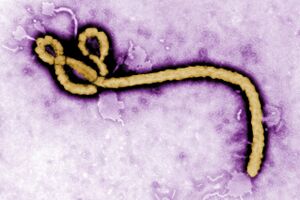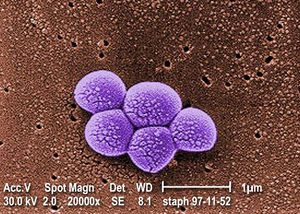Viral Replication and Ebola: Difference between revisions
| (13 intermediate revisions by the same user not shown) | |||
| Line 1: | Line 1: | ||
== | ==Introduction== | ||
[[Image:Ebolapurpleimage.jpg|thumb|300px|right| A transmission electron microscopy image of the Ebola virion. Photo credit: [https://www.wsj.com/articles/ebola-in-congo-starts-scramble-to-contain-outbreak-1494858534/ Wall Street Journal]]] | |||
The ebola virus genus which is responsible for the cause of Ebola Virus Disease (EVD), is a hemorrhagic fever virus in humans.<ref>Kadanali A, Karagoz G. An overview of Ebola virus disease. North Clin Istanb. 2015 Apr 24;2(1):81-86. doi: 10.14744/nci.2015.97269. PMID: 28058346; PMCID: PMC5175058.</ref> The U.S. Centers for Disease Control and Prevention (CDC) classifies Ebola as a Category A select agent, making it a “high-priority agent” as it threatens national security.<ref>Centers for Disease Control and Prevention. (2018, April 4). CDC. Centers for Disease Control and Prevention. https://emergency.cdc.gov/agent/agentlist-category.asp</ref> Ebolaviruses (EBOV) belong to the virus family Filoviridae which it shares with Marburgvirus and Cuevavirus.[1] EBOV genomes consist of non-segmented, single-stranded RNA structures that includes seven open reading frames.[5][15] The EBOV genome is approximately 18.9 kilobases long.[5] | |||
The EBOV genome encodes for seven genes each containing its own open reading frame.[3][6][28] The seven gene all aid in the viral entry and replication of the virus (Figure ): | |||
<br> | |||
<br> | |||
1)Glycoproteins(GPs) bind to the host's receptors on the cell's surface to insert its viral genome. | |||
<br> | |||
2)The Ebola Matrix Protein (VP40 NPs) gives EBOV its filamentous shape and directs the budding of enveloped viruses | |||
<br> | |||
3)Nucleoproteins are subunits of the Nucleocapsid that as whole protects the viral genome. | |||
<br> | |||
4)VP35, VP30, and VP24 proteins play roles in the formation of EBOVs helical nucleocapsid | |||
<br> | |||
5)The Polymerase (L) Protein is responsible for creating several copies of the RNA genome within hosts cells | |||
<br> | |||
==New Section== | ==New Section== | ||
| Line 21: | Line 36: | ||
<br> | <br> | ||
<br> | <br> | ||
Latest revision as of 19:05, 14 April 2024
Introduction

The ebola virus genus which is responsible for the cause of Ebola Virus Disease (EVD), is a hemorrhagic fever virus in humans.[1] The U.S. Centers for Disease Control and Prevention (CDC) classifies Ebola as a Category A select agent, making it a “high-priority agent” as it threatens national security.[2] Ebolaviruses (EBOV) belong to the virus family Filoviridae which it shares with Marburgvirus and Cuevavirus.[1] EBOV genomes consist of non-segmented, single-stranded RNA structures that includes seven open reading frames.[5][15] The EBOV genome is approximately 18.9 kilobases long.[5]
The EBOV genome encodes for seven genes each containing its own open reading frame.[3][6][28] The seven gene all aid in the viral entry and replication of the virus (Figure ):
1)Glycoproteins(GPs) bind to the host's receptors on the cell's surface to insert its viral genome.
2)The Ebola Matrix Protein (VP40 NPs) gives EBOV its filamentous shape and directs the budding of enveloped viruses
3)Nucleoproteins are subunits of the Nucleocapsid that as whole protects the viral genome.
4)VP35, VP30, and VP24 proteins play roles in the formation of EBOVs helical nucleocapsid
5)The Polymerase (L) Protein is responsible for creating several copies of the RNA genome within hosts cells
New Section

By [Author Name]
At right is a sample image insertion. It works for any image uploaded anywhere to MicrobeWiki.
The insertion code consists of:
Double brackets: [[
Filename: PHIL_1181_lores.jpg
Thumbnail status: |thumb|
Pixel size: |300px|
Placement on page: |right|
Legend/credit: Magnified 20,000X, this colorized scanning electron micrograph (SEM) depicts a grouping of methicillin resistant Staphylococcus aureus (MRSA) bacteria. Photo credit: CDC. Every image requires a link to the source.
Closed double brackets: ]]
Other examples:
Bold
Italic
Subscript: H2O
Superscript: Fe3+
- ↑ Kadanali A, Karagoz G. An overview of Ebola virus disease. North Clin Istanb. 2015 Apr 24;2(1):81-86. doi: 10.14744/nci.2015.97269. PMID: 28058346; PMCID: PMC5175058.
- ↑ Centers for Disease Control and Prevention. (2018, April 4). CDC. Centers for Disease Control and Prevention. https://emergency.cdc.gov/agent/agentlist-category.asp
